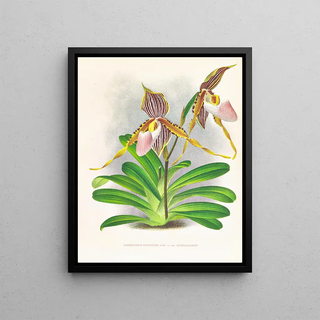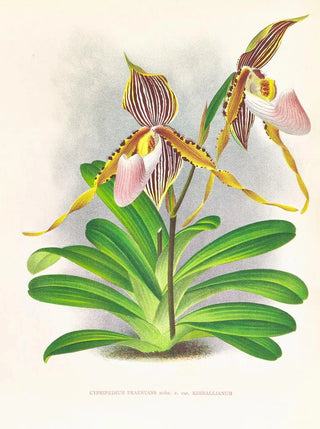Art print | Cypripedium excelle var. Kimballianum - Jean Jules Linden


View from behind

Frame (optional)
In the fascinating world of botanical art, the "Cypripedium excelle var. Kimballianum" by Jean Jules Linden stands out for its beauty and precision. This art print, imbued with infinite delicacy, transports us to a universe where nature is celebrated with artistic fervor. Jean Jules Linden, a 19th-century Belgian painter and botanist, masterfully captured the very essence of this rare orchid, revealing not only its morphological details but also its intrinsic charm. Contemplating this work, the viewer is invited to explore the richness of biodiversity while appreciating the undeniable talent of the artist.
Style and uniqueness of the work
The piece is characterized by a vibrant color palette and striking realism. Linden, through his brush, manages to bring each petal, each leaf to life, transforming a simple floral representation into a true ode to nature. His style, both meticulous and expressive, reflects attentive observation and a passion for botany. The delicate nuances of green and violet, combined with subtle lighting, create an almost enchanting atmosphere. This artistic approach goes beyond mere illustration, elevating to a poetic interpretation of flora, where every detail tells a story, and where each shadow and reflection reveals the magic of the plant world.
The artist and his influence
Jean Jules Linden, born in 1817, marked his era with his commitment to botanical art. His travels around the world, notably in South America, allowed him to discover unprecedented floral species which he later immortalized on canvas. His work is not just a simple representation; it is the result of a quest for knowledge and a desire to share the beauty of nature with the world. Linden contributed to the rise of botanical illustration, influencing many artists and scientists. His legacy endures today, reminding us of the importance of nature in our culture and art. Through his creations, he established a link between science and aesthetics, making his works treasures of

Matte finish

View from behind

Frame (optional)
In the fascinating world of botanical art, the "Cypripedium excelle var. Kimballianum" by Jean Jules Linden stands out for its beauty and precision. This art print, imbued with infinite delicacy, transports us to a universe where nature is celebrated with artistic fervor. Jean Jules Linden, a 19th-century Belgian painter and botanist, masterfully captured the very essence of this rare orchid, revealing not only its morphological details but also its intrinsic charm. Contemplating this work, the viewer is invited to explore the richness of biodiversity while appreciating the undeniable talent of the artist.
Style and uniqueness of the work
The piece is characterized by a vibrant color palette and striking realism. Linden, through his brush, manages to bring each petal, each leaf to life, transforming a simple floral representation into a true ode to nature. His style, both meticulous and expressive, reflects attentive observation and a passion for botany. The delicate nuances of green and violet, combined with subtle lighting, create an almost enchanting atmosphere. This artistic approach goes beyond mere illustration, elevating to a poetic interpretation of flora, where every detail tells a story, and where each shadow and reflection reveals the magic of the plant world.
The artist and his influence
Jean Jules Linden, born in 1817, marked his era with his commitment to botanical art. His travels around the world, notably in South America, allowed him to discover unprecedented floral species which he later immortalized on canvas. His work is not just a simple representation; it is the result of a quest for knowledge and a desire to share the beauty of nature with the world. Linden contributed to the rise of botanical illustration, influencing many artists and scientists. His legacy endures today, reminding us of the importance of nature in our culture and art. Through his creations, he established a link between science and aesthetics, making his works treasures of






